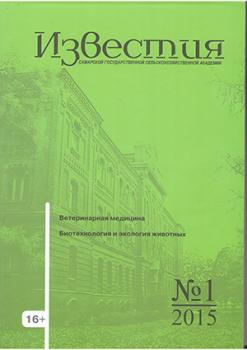Saratov, Saratov, Russian Federation
Saratov, Saratov, Russian Federation
Saratov, Saratov, Russian Federation
The purpose of the research is to reveal the features of influence of abiotic factors on the melliferous capacity of the base field rotations and the productivity of bee families in the period of maintenance and the main honey flow in conditions of the Volga region. The experience was laid in 2012-2014 in the Saratov CIS-Volga region, in the town of Balashov. The air temperature was taken into account on the basis of his own observations, and was also used meteorological data of the weather station. In the flowering period of crops daily recorded daily air temperature (1200 hours). The results of observations of the honey yield of honeybees (Krajina breed of bees (karnika) – Apis mellifera carnica Pollm.) in the flowering period of the main agricultural crops – nectarines (legumes, Cruciferae and Polygonaceae) in the steppe zone of the Volga region. The studies were conducted in a stationary apiary, located at 100-150 m from the agrocoenosis. Provides data of daily gain or loss of honey from control hives. Tendencies of influence of meteorological conditions when applying temperature, rainfall and other abiotic factors on the data of the gain control of the honey of the hive in the steppe zone of the Lower Volga region. The highest intensity of the honey production by bees (1375,0-1428,5 g/day) is the daily air temperature is 26±0,70 C, humidity 57-59%, against short-term precipitation and wind speed of 2.8-3.2 m/s. Period sustainable honey collection, including the main honey collection (July 10 – August 10), coincides geographically with prevailing cold North and northeast winds, the negative effects of which are offset by the terrain of the steppe zone of the Lower Volga region.
abiotic, honey, сhelopechene, beehive, honey, weight gain
1. Vorobyova, S. L. The Influence of abiotic factors for the productivity of bees in the Udmurt Republic [Electronic resource] // Modern problems of science and education. - 2015. - №1. - URL: http://www.science-education.ru/121-17806 (date accessed: 20.08.16).
2. Gaeva, D. V. Geoecological aspects of optimization of beekeeping in the system of agro-industrial complex of Kaliningrad region : abstract. dis. ... cand. geographer sciences : 25.00.36 / Gaeva Dara Vladimirovna. - Kaliningrad, 2015. - 24 p.
3. Gaeva, D. V. Influence of anomalous environmental conditions on the viability of bees // Bulletin of Baltic Federal University Kant. - Vol. 1. Natural science. - 2008. - P. 62-65.
4. Eskov, E. K. Microclimate bee home. - Moscow : Rosselkhozizdat, 1983. - 191 p.
5. Eskov, E. K. Temperature of maximum supercooling and state of fat body of bees // Beekeeping. - 2007. - № 6. - P. 22-23.
6. Korzh, V. N. The basics of beekeeping. - Rostov-na-Donu : Feniks, 2008. - 192 p.
7. Melnikov, A. V. Sequence of the flowering nectar and pyranone plants in the Western zone of the Saratov region / A. V. Melnikov, I. D. Eskov // Vavilovskaya reading : collection of articles of International scientific.-pract. conf. - Saratov : Bukva 2015. - P. 205-208.
8. Melnikov, A. V. The role of the bee in the environmental forest communities / A. V. Mel´nikov, D. I. Eskov, A. A. Turik [et al.] // landscape architecture and environmental engineering: history, development and prospects : materials of International scientific-practical conference. - Saratov : Cubik, 2012. - P. 64-66.
9. Murylev, A. V. Crystallization point of the tissues of the different parts of the body of the honeybees Apis mellifera mellifera l. and Apis mellifera carnica in the Perm region / A. V. Murylev, A. V. Petukhov // Vestnik OGU. - 2012. - №6 (142). - P. 145-149.





